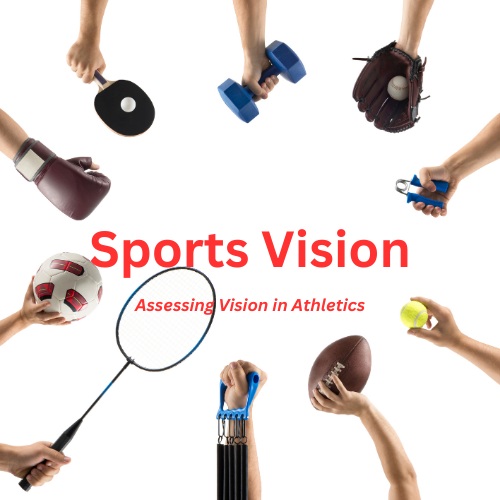Sports Vision: Visual Performance


Sports vision is defined, or assessed, by enhancing different parameters unique to that activity and athlete.
Visual performance assessments for sports refers to a set of tests and evaluations that are conducted to measure an athlete’s visual abilities and how they impact their performance on the field. These tests can help identify areas of strengths and weaknesses in an athlete’s visual system and provide feedback for targeted training to enhance their visual skills.
Some of the common tests that are done as part of visual performance assessments for sports include:
Visual acuity: This test measures an athlete’s ability to see fine details and distinguish between objects. It involves reading letters or symbols on an eye chart from a specific distance.
Depth perception: This test assesses an athlete’s ability to judge distances accurately, which is essential for sports such as baseball, soccer, and basketball.
Eye tracking: This test measures an athlete’s ability to follow a moving object accurately and quickly. It is especially important for sports that involve tracking fast-moving objects such as tennis, hockey, and football.
Contrast sensitivity: This test evaluates an athlete’s ability to distinguish between light and dark objects, which is crucial for sports that take place in low light conditions such as cycling and skiing.
Visual reaction time: This test measures an athlete’s ability to react quickly to a visual stimulus. It is important for sports that require quick reactions such as boxing and martial arts.
History of visual performance testing in sports
The history of sports vision testing can be traced back to the early 20th century, when eye exams were first conducted on baseball players. In the 1920s, Dr. Hermann Snellen developed the Snellen eye chart, which became the standard for measuring visual acuity. However, it was not until the 1980s that the importance of visual skills in sports was recognized, and specialized testing began to be developed for athletes.
One of the pioneers in visual performance testing for sports was Dr. Donald Teig, an optometrist who worked with the United States Olympic team in the 1980s. Dr. Teig developed a battery of tests to assess visual skills such as eye-hand coordination, depth perception, and peripheral vision. His work helped to raise awareness of the importance of visual skills in sports and led to the development of more sophisticated testing methods.
In the 1990s, the use of virtual reality technology in visual performance testing began to emerge. This allowed athletes to experience realistic sports simulations and provided a more accurate assessment of their visual skills. Today, there are a wide range of visual performance tests available for athletes, including computer-based assessments, virtual reality simulations, and on-field evaluations.
Sports-specific eyewear
Sports-specific eyewear refers to specialized eyewear designed for athletes to enhance their visual performance and protect their eyes during sports activities. These glasses or goggles are made with durable, impact-resistant materials and designed to provide optimal vision for specific sports.
Sports-specific eyewear can provide a range of benefits, depending on the sport and the athlete’s needs. For example, some types of sports eyewear have lenses that are designed to enhance contrast or reduce glare, which can improve an athlete’s ability to track fast-moving objects and react quickly. Other types of eyewear are designed to protect the eyes from impact or injury, such as in contact sports like basketball or hockey.
Examples of sports-specific eyewear include:
Swim goggles: These goggles are designed to be watertight and prevent water from entering the eyes during swimming or diving. They can also have tinted lenses to reduce glare when swimming outdoors.
Ski goggles: Ski goggles are designed to protect the eyes from the wind, snow, and UV rays during skiing or snowboarding. They often have lenses that enhance contrast and depth perception in low light conditions.
Basketball goggles: These are specialized goggles designed to protect the eyes during basketball games. They are typically made with impact-resistant materials and have a wrap-around design to provide full coverage and prevent injuries.
Baseball/softball sunglasses: These sunglasses have specialized lenses that enhance contrast and reduce glare, which can help batters track the ball better and make more accurate hits.
Cycling sunglasses: These sunglasses have a wrap-around design and are made with impact-resistant materials to protect the eyes during cycling. They often have tinted lenses that enhance contrast and reduce glare, which can improve visibility in different lighting conditions.
Overall, sports-specific eyewear can be an essential piece of equipment for athletes to optimize their visual performance and protect their eyes during sports activities.
Gregory Scimeca, M.D.
Ophthalmologist and Medical Director
The Eye Professionals
Our Locations
